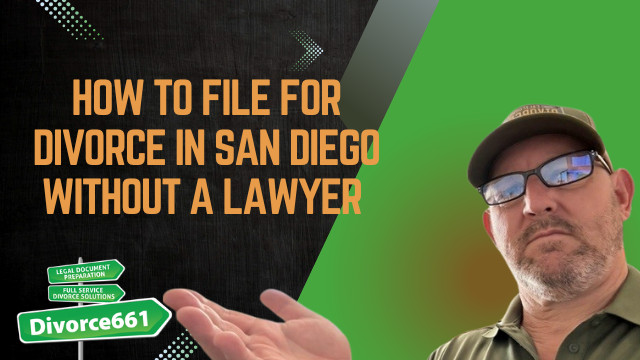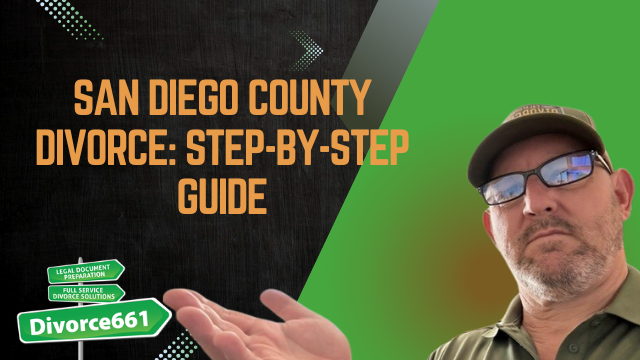What Happens After Filing for Divorce in San Diego?
Hi, I’m Tim Blankenship of Divorce661. If you’ve just filed for divorce in San Diego County, you probably have a lot of questions about what comes next. Filing the petition is only the first step — what happens after filing will determine how smoothly and how quickly your case moves toward finalization. Below I’ll walk you through the timeline, required steps, common pitfalls, and practical tips to keep your case moving forward without unnecessary delays.
Overview: The Big Picture
After your petition is filed, the process follows a predictable path:
- Serve your spouse (service of process).
- Exchange complete financial disclosures.
- Negotiate and document settlement terms (if the case is amicable).
- Prepare and submit the judgment package to the court.
- Wait out California’s mandatory six-month waiting period from the date of service.
Step 1 — Service of Process: Officially Notifying Your Spouse
Once the petition is filed, the next required action is serving your spouse with court‑stamped copies of the petition and summons. Proper service is critical because it officially starts the clock on the legal timeline.
Service is what officially starts the mandatory six-month waiting period required before your divorce can be finalized.
Key points about service in California:
- You generally cannot serve the documents yourself.
- Service can be completed by a third party such as a process server or the sheriff.
- If your spouse is cooperative, service can often be done by mail if they sign a Notice and Acknowledgement of Receipt.
Step 2 — Financial Disclosures: What the Court Requires
California requires full, honest financial disclosures from both parties in every divorce case — even when the divorce is uncontested and amicable. The court will not approve a final judgment without these disclosures.
Typical disclosures include:
- Income documentation: recent pay stubs, W-2s, and tax returns.
- Detailed lists of assets: bank accounts, retirement accounts, real property, vehicles, business interests.
- Debts and liabilities: mortgages, credit cards, loans.
- Monthly expenses and budgets.
Exchange these disclosures promptly and accurately. Incomplete or late disclosures are a common source of delay and can lead to court requests for additional information.
Step 3 — Settlement & the Marital Settlement Agreement
If you and your spouse can reach agreement on issues like property division, debt allocation, support, and custody, you’ll put those terms into a Marital Settlement Agreement (MSA). The MSA becomes part of your final judgment paperwork and controls the outcome once the court signs the judgment.
What to include in an MSA:
- Division of assets and debts.
- Spousal support terms (if any).
- Child custody and visitation arrangements and child support calculations.
- Any additional terms for responsibility, insurance, tax matters, or future dispute resolution.
Step 4 — Preparing the Judgment Package & Filing with the Court
Once disclosures are exchanged and the MSA is signed, the next step is preparing the judgment package. In San Diego County we file everything electronically, which speeds processing and allows us to track the case and respond quickly to any court requests for corrections.
The court will review your package and may ask for minor edits or additional documents. We track those requests, make corrections, and re-submit until the court approves and signs the judgment.
When does the divorce become official?
Even after the court signs the judgment, California’s mandatory waiting period still applies. The divorce becomes final six months after the date your spouse was served (or the date they signed the Notice of Acknowledgement if served by mail). That six-month waiting period cannot be waived.
Real Client Example: From Filing to Final Judgment Package in 30 Days
To give you a concrete example: we recently helped a San Diego couple file their petition, complete and exchange disclosures, reach a full agreement, and submit the final judgment package — all within 30 days. The court processed their paperwork without any required appearances or corrections, and now they are simply waiting out the six‑month window for their divorce to become final.
How Divorce661 Helps — What We Handle For You
At Divorce661 we specialize in managing the steps that follow filing your petition so your case proceeds efficiently:
- Handling service of process correctly (process server, sheriff, or mail with acknowledgment).
- Preparing and organizing complete financial disclosures.
- Drafting a clear Marital Settlement Agreement when parties are in agreement.
- Preparing and electronically filing the judgment package in San Diego County.
- Tracking the case, responding to court correction requests, and ensuring timely submission.
Common Pitfalls & Tips to Avoid Delays
- Don’t delay service: The six‑month clock starts on service, so serve as soon as practical.
- Complete disclosures thoroughly: Missing documents or incomplete financials are the most common reason for hold-ups.
- Respond to court requests quickly: Small corrections can turn into weeks of delay if ignored.
- Keep communication professional: In amicable cases, cooperation (like signing a mail acknowledgment) can save time and money.
- Use electronic filing when available: It speeds processing and reduces clerical errors.
Conclusion — Move From Filing to Finalization with Confidence
Filing for divorce is the first formal step, but the actions you take afterward determine how quickly your case reaches a final judgment. Proper service, complete financial disclosures, a well-drafted settlement agreement, and a correctly prepared judgment package are the keys to a smooth process. If you want to avoid court delays and confusion, get the paperwork right and keep the process organized.
If you’ve already filed or are about to, visit Divorce661.com to schedule a free consultation. We’ll help you move from filing to finalization with confidence and peace of mind.










